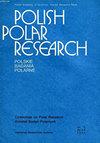Ice surface near melting point: Effects on the tropospheric ice
IF 0.8
4区 地球科学
Q4 ECOLOGY
引用次数: 0
Abstract
: Atmospheric gases and chemical impurities can be stored and chemically transformed in the tropospheric ice. Impurities are rejected during freezing of the ice to the grain boundaries, free ice surfaces or inclusions. Surface snow and tropospheric ice, however, may be exposed to high temperatures and, eventually, the gases and chemical impurities can be released into the environment. It is important to study the surface structure and transport mechanisms at temperatures near the melting point because the location of impurities and their interactions with water molecules in the ice are not yet sufficiently explained. In this work, the evolution of a scratch on the bicrystalline ice surface was studied at –5℃. The surface transport mechanisms near the melting point were studied and, as a consequence, the surface structure could be determined. An ice sample was kept immersed in ultra-pure silicone oil to prevent evaporation and, thus, isolate the effect of surface diffusion. The ice sample was made with water with chemical conditions similar to the water of polar ice sheets. Photographs of the scratch were taken periodically, for approximately 50 hours, using a photographic camera coupled to an optical microscope. From these images, the evolution of the width of the scratch was studied and the surface diffusion was the dominant transport mechanism in the experiment. Finally, the ice surface self-diffusion coefficient at –5℃ was determined and it was very similar to the super-cooled water diffusion coefficient. A liquid-like behavior of ice surfaces near the melting point was found and it could have a strong influence on the reaction rates with atmospheric gases.接近熔点的冰表面:对对流层冰的影响
本文章由计算机程序翻译,如有差异,请以英文原文为准。
求助全文
约1分钟内获得全文
求助全文
来源期刊

Polish Polar Research
ECOLOGY-GEOSCIENCES, MULTIDISCIPLINARY
CiteScore
2.00
自引率
7.70%
发文量
0
审稿时长
>12 weeks
期刊介绍:
The quarterly Polish Polar Research edited by the Committee on Polar Research of the Polish Academy of Sciences is an international journal publishing original research articles presenting the results of studies carried out in polar regions.
All papers are peer-reviewed and published in English.
The Editorial Advisory Board includes renowned scientist from Poland and from abroad.
 求助内容:
求助内容: 应助结果提醒方式:
应助结果提醒方式:


